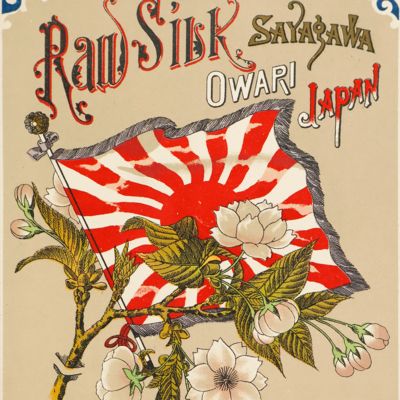[Trade Catalogue - Japanese Silk]
Well-known raw silk producers and their trade marks - Empire of Japan - Compiled for Louisiana Purchase Exposition 1904.
Tokio [Tokyo], The Japan Sericultural Association, 1904. Folio (29.6 x 22.0 cm). Preliminary leaf, title page, (xiv [advertisements]), 166, 7, [ix] pp. 144 text illustrations (logos), of which 142 in colour - mostly in full colour chromolithography, a few partly printed in silver. Additional full-colour illustrations in the advertisement sections. Original multi-colour pochoir wrappers, with two silk ties. Printed erratum leaf tipped in.
A very rare survey of Japanese silk producers, prepared for the 1904 Louisiana Purchase Exposition. In all 144 companies present themselves here, each providing a - mostly very colourful - logo, often depicting birds, as well as various other animals, flowers, geishas, warriors, etc. Included is an overview of the silk industry and its history. Between 1850 and 1930, raw silk ranked as the leading export of Japan, accounting for 20 per cent to 40 per cent of Japan’s total exports. Between the 1890s and the 1930s, Japanese silk exports quadrupled, making Japan the largest silk exporter in the world. "The Louisiana Purchase Exposition, informally known as the St. Louis World's Fair, was an international exposition held in St. Louis, Missouri, United States, from April 30 to December 1, 1904. Local, state, and federal funds totaling $15 million were used to finance the event. More than 60 countries and 43 of the then 45 American states maintained exhibition spaces at the fair, which was attended by nearly 19.7 million people" (Wikipedia). It was by far the most important world fair before WWI." The Japanese government spent lavishly: $400,000, plus $50,000 from the Japanese colonial government of Formosa, with an additional $250,000 coming from Japanese commercial interests and regional governments". This lavishly illustrated work was not for sale and it seems likely that most copies ended up in governmental libraries. This copy, however, is not a library copy, and apart from some very light wear to the wrappers is in excellent condition. Provenance: inscribed on the front free endpaper, William Streuli from Berizzi Bute [?]. One copy in the collection of The Met in New York City, and one copy recorded in OCLC, in a Danish library. We found only one auction record.




